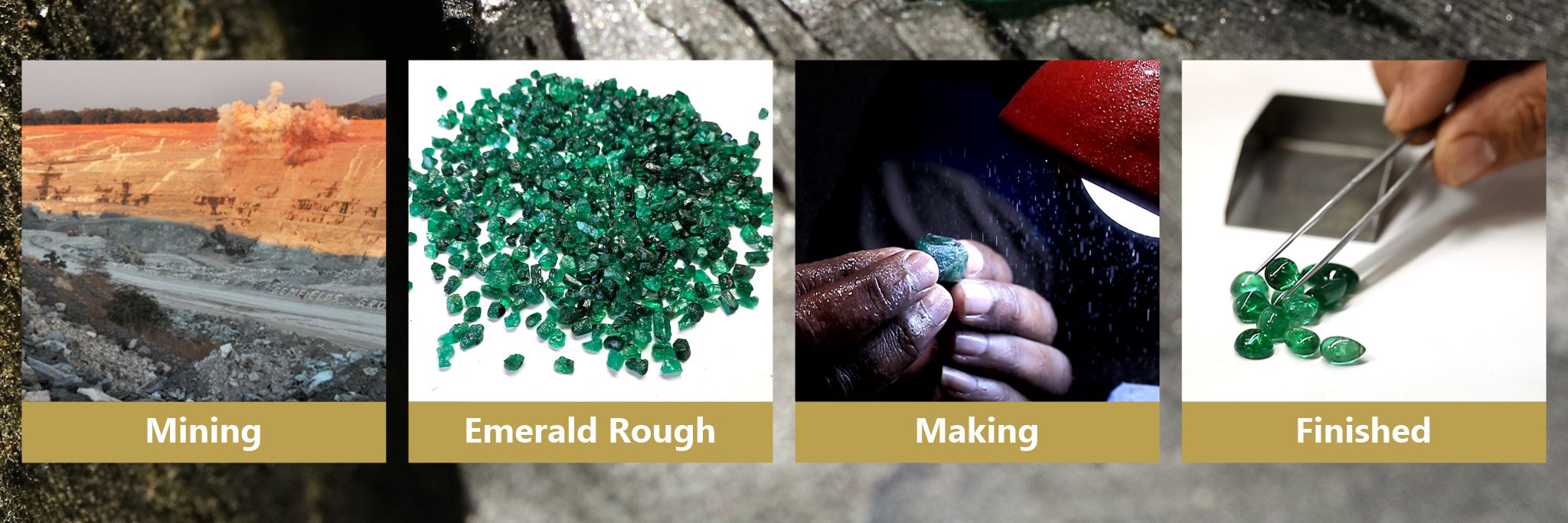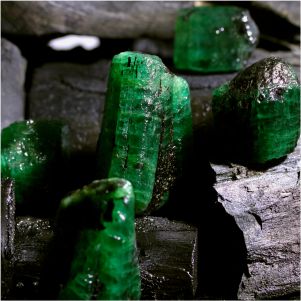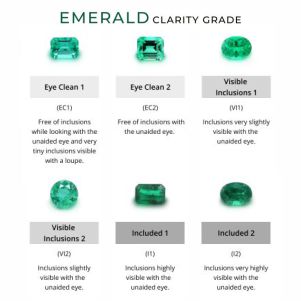

We are mining best quality Emerald rough from Lusaka, Zambia
Mining

We extract high quality emerald rough from the mines in Zambia and get it imported to India.
Raw Material (Emerald Rough)

We are known for cutting and polishing of Zambian Emeralds with good finish.
Processing

Finished Zambian Emeralds are graded based on cut, clarity, color and shape of emeralds as per the international standards of IGI & GIA.
Grading

Emeralds are then certified as a Natural Stone from reputed Gem Testing Laboratories.
Certification

We always deliver the original Zambian Emeralds through Bluedart, Delhivery, Ecom Express with safe, secure & insured packaging.
Delivery & Support
Frequently Viewed Videos
Why Choose Us !!
We are known for producing and supply of Zambian Emeralds in free and calibrated MM sizes. We have the best of the stone cutting and polishing workers who has family legacy in this field for last 100 years. The key to any Emerald is cut, clarity and polishing to showcase the maximum lusture and color intensity on all the sides. The best quality emerald is mined in Zambia but best hand polished in India by workers of Seven Emerald Stones. Our company has strong presence in Zambia for Emeralds. Miners in Lusaka Field Zambia are directly the part of the company for supply of best quality rough Emerald. The company has unique selection methods, cutting and polishing of Emeralds to give you best fine piece.
Zambian emeralds are prized gemstones known for their deep green color and exceptional clarity. These emeralds are typically categorized into three main types based on their appearance and characteristics:
1. Classic Zambian Emeralds: These emeralds are renowned for their rich green hue with slight hints of blue. They often exhibit excellent transparency and brilliance, making them highly desirable for jewelry settings.
2. Zambian "Water" Emeralds: This type of Zambian emerald is characterized by its intense, vivid green color reminiscent of the lush greenery found in tropical rainforests. These emeralds are valued for their striking appearance and are often sought after by collectors and connoisseurs.
3. Zambian "Garden" Emeralds: Garden emeralds are distinguished by their unique inclusions, which resemble intricate patterns or formations resembling a garden landscape. These inclusions, though visible, add character and charm to the gemstone, making each piece distinct and captivating.
- In Zambian emeralds, transparency can vary based on the presence and characteristics of inclusions within the gemstone. Here are some common types of transparency in Zambian emeralds:
1. Transparent: These emeralds have excellent clarity, with minimal to no visible inclusions when viewed under normal conditions. Light can pass through the gemstone with little obstruction, allowing for maximum brilliance and sparkle.
2. Semi-Transparent: Semi-transparent emeralds have slight to moderate inclusions that may be visible under close inspection but do not significantly detract from the overall beauty of the gemstone. Light can still penetrate the stone, although it may be slightly diffused by the inclusions.
3. Translucent: Translucent emeralds have a milky or hazy appearance due to a higher concentration of inclusions or internal fractures. While light can still pass through the gemstone, it may be scattered or diffused, resulting in reduced brilliance and a softer glow.
4. Opaque: Opaque emeralds have a solid, non-transparent appearance, where light cannot penetrate the stone at all. These emeralds typically have significant inclusions or impurities that completely obscure any internal features. Opaque emeralds are less common and usually not as highly valued as transparent or translucent ones.
These different types of transparency in Zambian emeralds can affect their overall beauty, value, and suitability for various jewelry designs. Gemstone professionals often assess transparency alongside other factors such as color, clarity, and cut when evaluating the quality of emeralds.
- Clarity in Zambian emeralds refers to the presence, absence, and visibility of internal characteristics, also known as inclusions, within the gemstone. Due to the way emeralds are formed, it's quite common for them to contain various inclusions, such as mineral deposits, fractures, and tiny crystals. These inclusions are often referred to as the "jardin," meaning garden in French, due to their resemblance to foliage.
In Zambian emeralds, clarity can vary significantly from stone to stone. Some may have exceptional clarity with few or no visible inclusions, while others may have a higher number of inclusions that are more apparent to the naked eye. Clarity is graded on a scale ranging from "Eye-Clean," where inclusions are not visible to the unaided eye, to "Included," where inclusions are readily visible and may affect the stone's overall appearance.
Common cuts for Zambian emeralds include the classic emerald cut, which features step-cut facets that emphasize the gem's clarity and color, and the brilliant cut, which incorporates facets to maximize the stone's sparkle and brilliance. Other popular cuts include oval, pear, and cushion cuts, each offering unique characteristics and aesthetics.
Carat weight is a crucial aspect of evaluating Zambian emeralds, determining their size and, to some extent, their value. Like other gemstones, the carat weight of Zambian emeralds refers to their mass, with one carat equaling 200 milligrams. Due to the rarity and high demand for large, high-quality emeralds, carat weight can significantly impact the gem's value. However, it's essential to note that carat weight alone does not determine an emerald's worth; factors such as color, clarity, and cut also play pivotal roles. In Zambian emeralds, as with emeralds from other sources, larger specimens with vivid green color, exceptional clarity, and excellent cut command premium prices. However, finding large, high-quality emeralds can be challenging due to the gemstone's natural occurrence and the difficulty of extracting large, flawless crystals from the earth.
